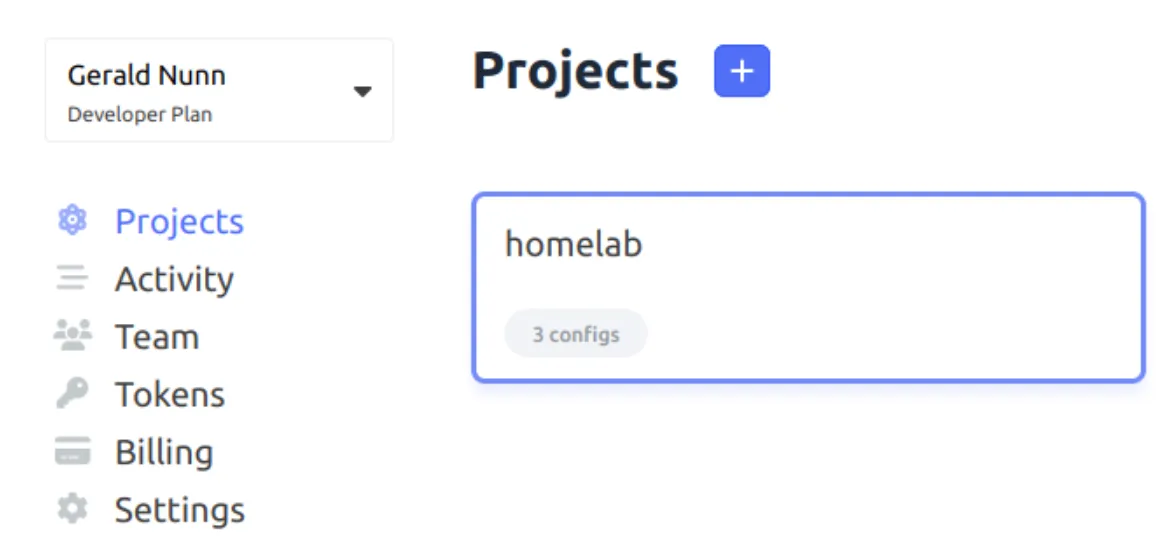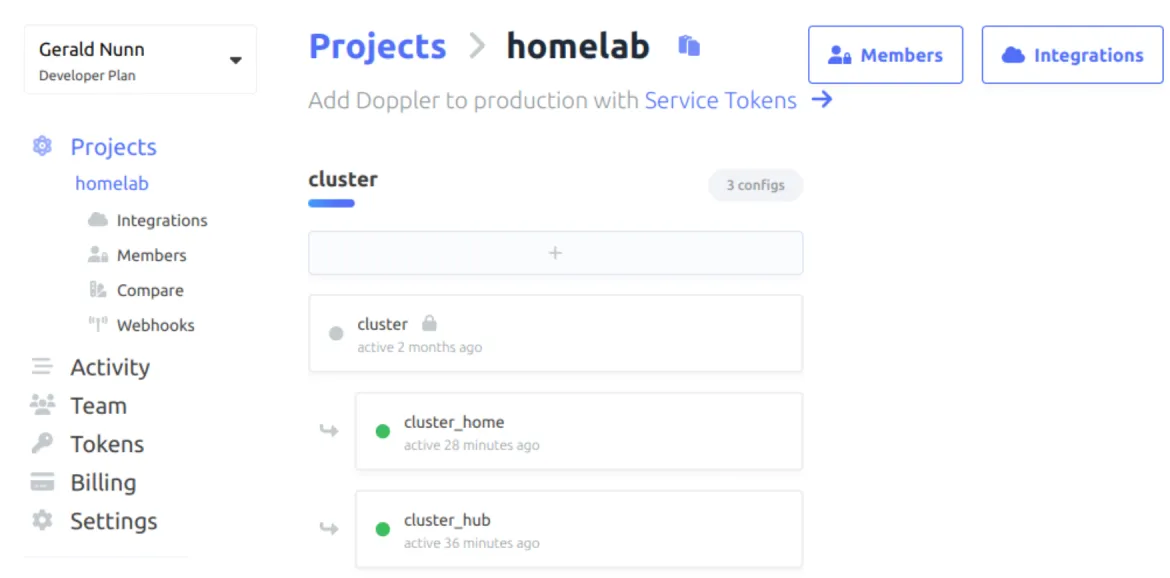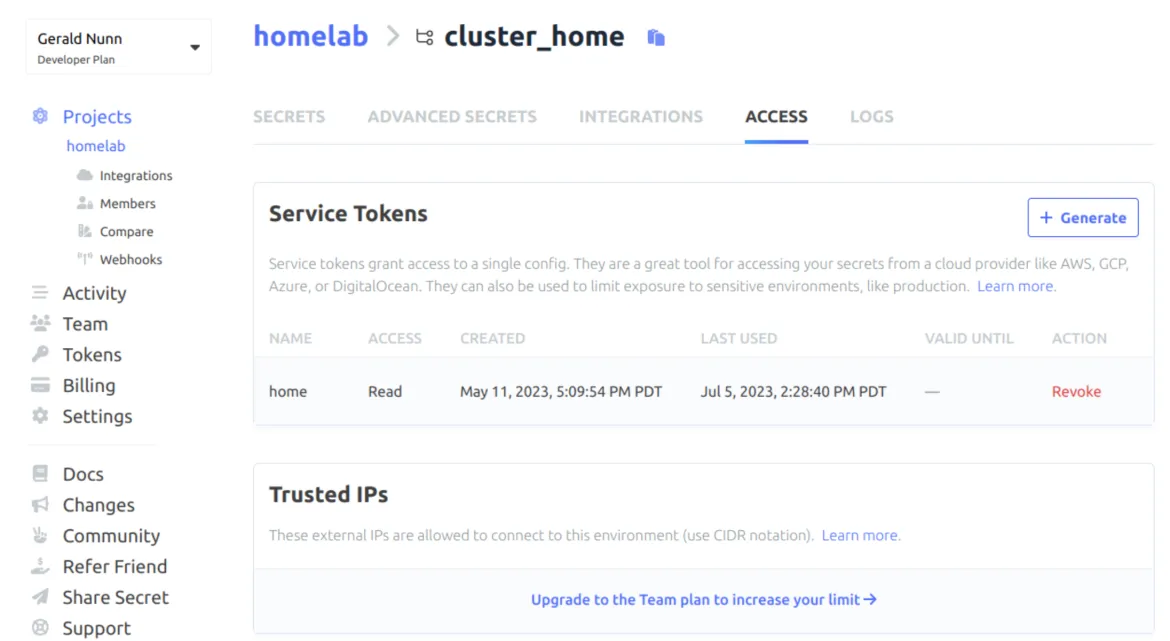Managing secrets when using GitOps to manage Kubernetes clusters and applications is challenging with many potential solutions. These solutions tend to fall into one of two following patterns:
- Encrypt secrets in Git. SealedSecrets and Mozilla SOP are examples of this.
- Externalize secrets. Examples include solutions like Hashicorp's Vault or a cloud provider's key management solutions coupled with the External Secrets Operator or the Secrets CSI driver.
I recently acquired a second server in my home lab. While I was relatively satisfied with SealedSecrets as a simple way to manage secrets, the second server increased my desire to examine externalizing my secrets for the benefit of centralization.
Since this is for a home lab scenario, minimizing costs is important. As a result, I settled on using the External Secrets Operator (ESO) along with the Doppler provider as the back-end for a completely free solution. The Secrets CSI driver is a fine solution, but at the time of this writing, the only free provider it supported was Community Vault, which requires significant effort to set up.
This blog looks at setting up ESO in a cluster to access secrets in Doppler. While I use Doppler, much of what I show applies to other providers. A complete list of providers that ESO supports is available here, and the specific documentation on using Doppler as a provider is available here.
External Secrets Operator Installation
Since I am doing GitOps, it is only natural to install the External Secrets Operator in OpenShift using OpenShift GitOps. Fortunately, this exercise is made trivial thanks to the efforts of the Red Hat GitOps Community of Practice team, which maintains a catalog of community-supported manifests for installing commonly used software. This catalog already contains manifests for the External Secrets Operator, found in GitHub.
The catalog splits the installation into the operator and an ESO instance. However, I prefer to use a single Argo CD Application to install both. This is easy to accomplish by using a customization to aggregate both items together as follows:
kind: Kustomization
apiVersion: kustomize.config.k8s.io/v1beta1
commonAnnotations:
argocd.argoproj.io/sync-options: SkipDryRunOnMissingResource=true
resources:
- github.com/redhat-cop/gitops-catalog/external-secrets-operator/operator/overlays/stable
- github.com/redhat-cop/gitops-catalog/external-secrets-operator/instance/overlays/default
Note that I use the SkipDryRunOnMissingResource annotation to prevent the application from failing due to the required Custom Resource Definitions not being installed ahead of the instance.
Next, create an Argo CD application pointing to your repository's above customization file. Here is an example:
apiVersion: argoproj.io/v1alpha1
kind: Application
metadata:
name: external-secrets
namespace: openshift-gitops
spec:
destination:
namespace: openshift-operators
server: https://kubernetes.default.svc
project: cluster-config
source:
path: components/apps/eso/overlays/aggregate
repoURL: https://github.com/gnunn-gitops/cluster-config.git
targetRevision: HEAD
syncPolicy:
automated:
selfHeal: true
Sign up for Doppler
Before proceeding further with ESO, you will need to create an account with Doppler (or the provider of your choice). A Developer level account is available for free with Doppler, and I have found it sufficient to meet the needs for home labs or learning. As a small plug for Doppler, I like the fact that some of the more advanced features, like branching, remain available in the free tier.
To sign up for an account, visit doppler.com and follow their registration procedure. It is straightforward, and I shan't elaborate on it here.
Once you can access your account, click Projects, as this is where you set up secrets. When you first log in to Doppler, you will notice it has a default project. I deleted it and created a new one called "homelab" as per the screenshot below. However, feel free to use whatever name suits your needs. Note also that you can have multiple projects. You can have one project for cluster configuration and one or more application projects. Again, how you organize things is up to you.
Within the confines of a Project, Doppler assumes you will have environments like configs following dev, stage, and prod. In my case, I do not need these, so I opted to have a single base config called "cluster" that will contain the common secrets used across all clusters. For cluster-specific secrets, I opted to leverage Doppler's branch feature, where each config inherits from the root config but allows me to override or add additional secrets to the branch config.
I have two clusters in my home lab—home and hub—represented by the two branches shown below. Note I'm still relatively new to Doppler, so thoughts would be welcome on whether using environments or branches to model different clusters is better.
I can now add the secrets into Doppler as needed. I'll leave this as an exercise for you. However, I recommend reading the next section first to understand how ESO handles multi-key secrets, such as certificates, to minimize maintenance.
Finally, I need to configure an access token for ESO to pull secrets from Doppler. In Doppler, the access tokens are associated with the config. I created individual access tokens for the two branch configs, cluster_home and cluster_hub, to use with my home and hub clusters, respectively.
Configure an ESO SecretStore
For ESO to access a secrets provider, I need to define a secrets store. ESO supports a ClusterSecretStore and SecretStore, which are cluster and namespace scoped, respectively. For simplicity in my home lab, I used the ClusterSecretStore to provide cluster-wide access to secrets.
For folks operating in a more real environment, I recommend checking out the ESO multi-tenancy documentation. The TL;DR is that you will likely need to use the namespace-scoped SecretStore to operate safely in a multi-tenant OpenShift environment.
Here is an example of the ClusterSecretStore I am using:
apiVersion: external-secrets.io/v1beta1
kind: ClusterSecretStore
metadata:
name: doppler-cluster
spec:
provider:
doppler:
auth:
secretRef:
dopplerToken:
name: eso-token-cluster
key: dopplerToken
namespace: external-secrets
Notice that this is referencing a secret. This secret contains the cluster-specific access token and thus varies with each cluster. An example of this secret is as follows (minus the real token, of course):
apiVersion: v1
kind: Secret
metadata:
name: eso-token-cluster-home
namespace: acm-policies
data:
dopplerToken: XXXXXXX
While not in the scope of this blog, I'm using the RHACM policygenerator to distribute the ClusterSecretStore and secret to the managed clusters along with my GitOps installation. Interested readers can see it here.
Create an ExternalSecret
Here is the fun stage—creating ExternalSecret objects to reference the secrets in Doppler. The ESO guides do an excellent job of covering the common patterns used to create secrets, so I want to highlight a couple of the more common patterns I've been using.
- All keys, one secret. It is common to have a secret that has multiple keys in it. For example, certificates typically need keys for the private certificate, a public certificate, and a CA. While you can store each of these as separate key-pairs in your secret provider, it can be painful. ESO allows you to keep these key-value pairs in Doppler as a single JSON document and will automatically decompose it into multiple key-pairs in the secret.
Also, note that the Import Secrets feature in Doppler can reduce the effort involved in using this pattern.
- Common Secret Types. Kubernetes supports various secret types besides generic, including basic-auth, tls, docker, etc. In ESO, you can use templating to create secrets of the required type. For example, here is a secret for a dockerconfigjson type:
apiVersion: external-secrets.io/v1beta1
kind: ExternalSecret
metadata:
name: dest-docker-config
namespace: product-catalog-cicd
spec:
refreshInterval: 1h
secretStoreRef:
name: doppler-cluster
kind: ClusterSecretStore
target:
template:
type: kubernetes.io/dockerconfigjson
data:
.dockerconfigjson: "{{ .docker_secret | toString }}"
name: dest-docker-config
creationPolicy: Owner
data:
- secretKey: docker_secret
remoteRef:
key: DOCKER_CONFIG_JSON
Wrap up
ESO provides an easy way to access secrets from an external centralized provider.
저자 소개
유사한 검색 결과
채널별 검색
오토메이션
기술, 팀, 인프라를 위한 IT 자동화 최신 동향
인공지능
고객이 어디서나 AI 워크로드를 실행할 수 있도록 지원하는 플랫폼 업데이트
오픈 하이브리드 클라우드
하이브리드 클라우드로 더욱 유연한 미래를 구축하는 방법을 알아보세요
보안
환경과 기술 전반에 걸쳐 리스크를 감소하는 방법에 대한 최신 정보
엣지 컴퓨팅
엣지에서의 운영을 단순화하는 플랫폼 업데이트
인프라
세계적으로 인정받은 기업용 Linux 플랫폼에 대한 최신 정보
애플리케이션
복잡한 애플리케이션에 대한 솔루션 더 보기
오리지널 쇼
엔터프라이즈 기술 분야의 제작자와 리더가 전하는 흥미로운 스토리
제품
- Red Hat Enterprise Linux
- Red Hat OpenShift Enterprise
- Red Hat Ansible Automation Platform
- 클라우드 서비스
- 모든 제품 보기
툴
체험, 구매 & 영업
커뮤니케이션
Red Hat 소개
Red Hat은 Linux, 클라우드, 컨테이너, 쿠버네티스 등을 포함한 글로벌 엔터프라이즈 오픈소스 솔루션 공급업체입니다. Red Hat은 코어 데이터센터에서 네트워크 엣지에 이르기까지 다양한 플랫폼과 환경에서 기업의 업무 편의성을 높여 주는 강화된 기능의 솔루션을 제공합니다.




